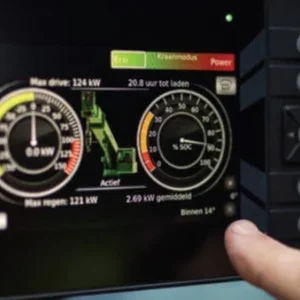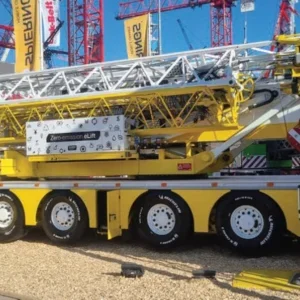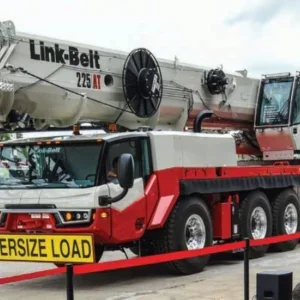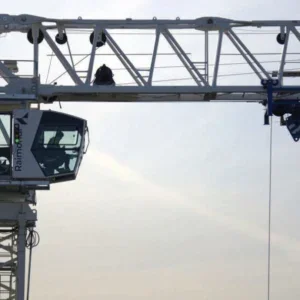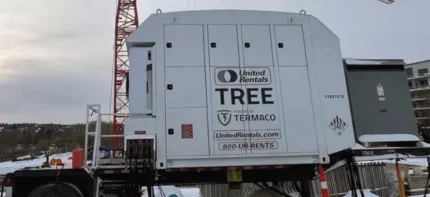
Let’s start large, with the strongest land-based crane in the word: Mammoet’s SK6000 – which can lift up to 6000 tonnes. But did you know that this titan of the lifting world can now be powered by batteries? That’s right; at the end of 2024 Mammoet announced that it had been tested for fully electric operation – opening up zero-emission capability to projects taking place anywhere in the world. This means at sites without power network access or with supply stability issues it can be powered via batteries.
The technology reduces the noise generated by crane operations, says Mammoet, resulting in a better work environment where communication is easier. In turn, large projects are made safer, cleaner, and easier to finance.
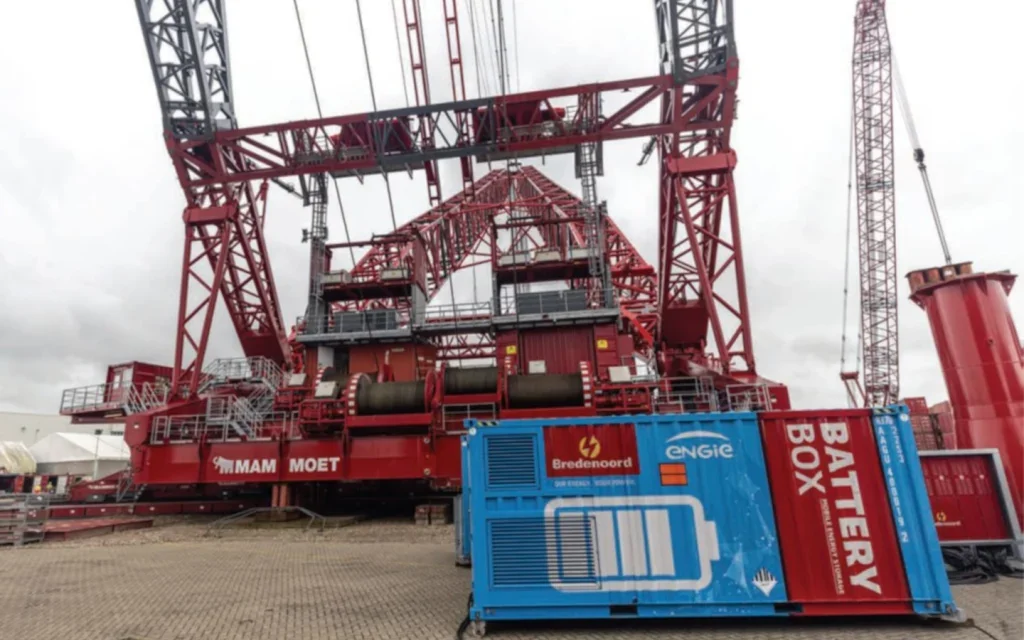
Testing was carried out using two 600kWh ‘Battery Boxes’ from Netherlands headquartered power supply specialist Bredenoord connected in series to deliver 1,200kWh. This is around the same output as 20 electric cars.
Connection took a day shift, in parallel with test weight reconfiguration activity. This, Mammoet says, demonstrates that the utilisation of batteries has minimal impact on site operations.
Battery packs capable of operating the SK6000 are becoming widely available in standard 20ft shipping container form, facilitating easy mobilisation to and from site.
Niek Bezuijen, global sustainability advisor at Mammoet, said: “Thanks to this test we can now say that the SK6000 operates fully zero-emissions onsite. Electrification isn’t a matter for the future of heavy lifting – it is needed now, and through innovations like this Mammoet can help its customers lead on safety, efficiency, sustainability and cost.”
Battery functionality also has the advantage of being chargeable from lower power networks. The significant periods of time between individual ring crane lifts allow the chance for battery packs to recharge.
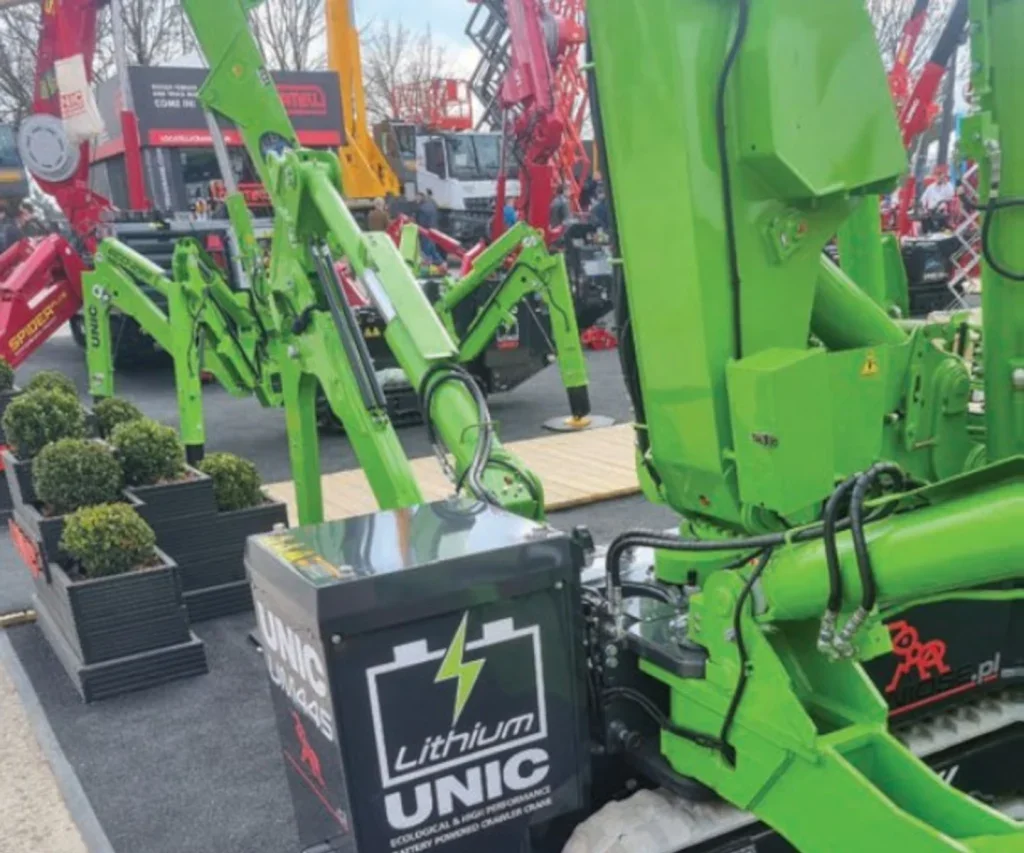
Alternatively, the crane can be plugged into a medium voltage network ‘shore power’ connection – commonly available in heavy industry and at port facilities. Where neither grid power nor battery power are an option hydrogen generators can be used.
The project was part-funded by the Subsidieregeling Schoon en Emissieloos Bouwmaterieel in the Netherlands; a research and demonstration fund to develop zero-emission initiatives at construction sites.
A video about the project can be seen on the CT website, here: https://shorturl.at/CKEO6.
In contrast to the sheer size of Mammoet’s massive ring crane we have the latest mini spider crane from Japanese manufacturer Unic: the URW 806-3 – which launched at the recent Bauma 2025 tradeshow. It has an eighttonne lifting capacity and builds on the legacy of Unic’s industry workhorse, the URW-706-2.
Crucially, the new mini crane can be powered by a brand-new battery: the ECube – a small interchangeable cube battery that attaches to the back of the mini crane.
“What we’ve created here is a portable power supply unit,” says Scott Ainsworth, technical support director at Unic Cranes Europe, the European master-distributor for Unic, and part of the GGR Group. “It can give you 220 volts or 415 volts from a 250 amp-hour battery back. The lithium technology means that it can be charged on site while it’s still being used; or you can put it on 110V overnight to recharge it, ready to go again in the morning. It can charge on 110V 32 amp, 240V 16A, or 415V 32A. Having the different input charging voltages gives us more options on the job site. A construction site, for example, may well not have 415V available. A full charge gives an average running time of two hours continuous usage on the spider crane.”
Although two hours might not seem long, this is continuous use. “In real life nobody operates a spider crane for two hours continually,” Ainsworth explains. “The crane does a bit of lifting, then a pause, then a bit more lifting: it is on and off. We expect that time to increase. As operators become more familiar with using the machine we’re sure our battery consumption time will extend, too.
“We can mount the battery onto the machine; or another option for the customer would be to take an ECube pack and electric motor controller pack. They could then add that to their fleet as a simple bolt-on to any machine they want.”
Motives for doing this include flexibility, economy, and even obtaining the tender for the job in the first place: “We are seeing more and more experiences of construction sites limiting the noise and the exhaust emissions – contractors are paying higher taxes on emissions in London. If you are working a machine running off an ECube those issues disappear.”
The ECube does not have to be used only on a crane. “There are various other things that we can do with it. It can also act as an emergency power supply: if your office supply goes down, you can plug this in and you have got all your electronics and IT back. It is really portable, so if one of your staff EV cars has run out of power you can simply take this to them, sit the vehicle on charge for an hour or two, and then they can carry on driving themselves.
“As well as the 250A hour version we make a 125A hour one, which gives a 24V output; and the next one up from the 250 is the 500A hour, which has all the same characteristics but is just a little bit bigger.”
TOWER POWER
Battery power for cranes is a fast-moving area with both new technologies and new users. Battery start-ups are seeking distributors and crane-rental companies who will hire out their battery-power units along with their cranes. They are also seeking crane manufacturers with whom to form close and continuing relationships.
In the USA, for example, United Rentals (which claims to be the world’s largest equipment rental company) has added battery energy systems for tower cranes to its North American rental fleet. Developed by Termaco, and configurable up to 500kW, the system operates alongside a generator to deliver reliable power to support tower crane operations. It minimises generator run time by storing energy in batteries and running on battery power whenever possible. For smaller applications, the battery unit can even be powered, in whole or in part, by solar panels to create a completely emissions-free solution. The end result, for this and for other battery solutions, is to allow contractors to significantly downsize the generator for their tower crane and dramatically reduce generator run time and emissions while still meeting peak power demands.
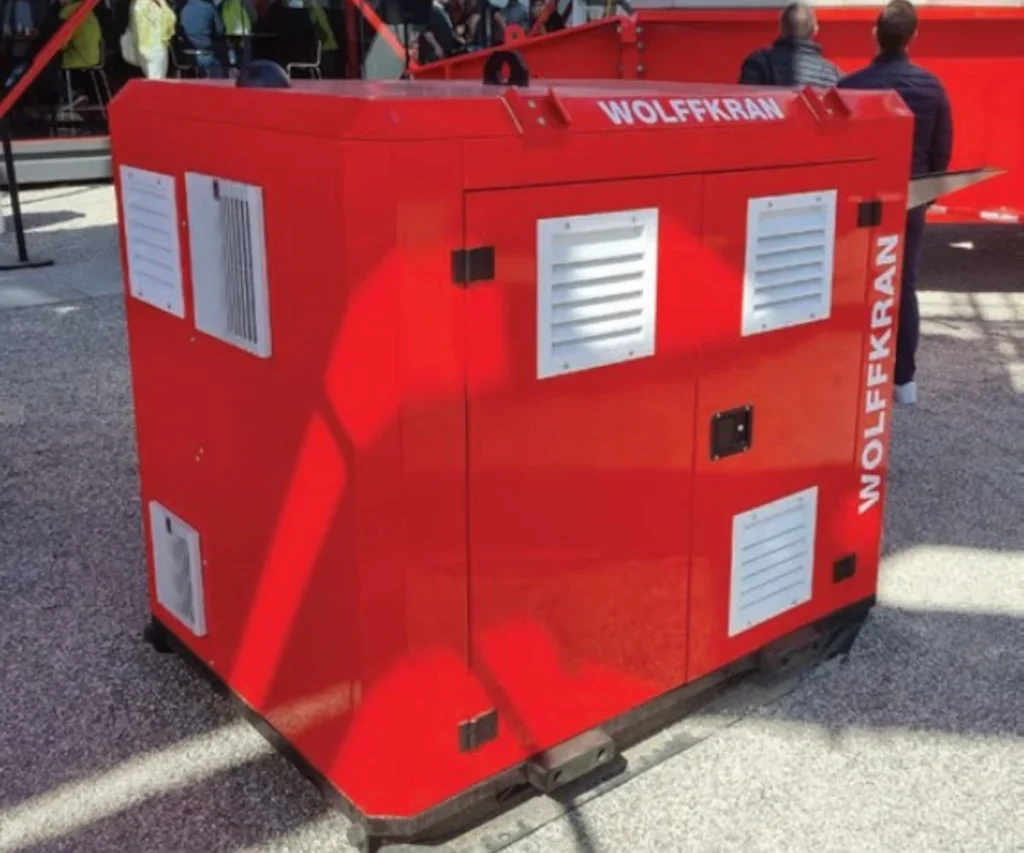
MONEY SAVERS
Then there’s Wolff Onsite, the accessories division of tower crane manufacturer Wolffkran, which, at Bauma, showcased the Enertainer – a battery energy storage system from Singapore-headquartered energy storage specialist Ampd.
“The Enertainer is a conventional lithium battery energy storage system and it can power multiple pieces of kit,” explains Tom McDaid, managing director of Wolff Onsite. “We have a site in Manchester where we had two cranes and two hoists, powered by four diesel generators. So you can imagine four generators burning all day – but they’re under load only intermittently. So we brought in the Enertainer which can run either off a small grid connection or off a single 100KVA generator.
“At this particular site there was a temporary grid connection but it was only 90 amps; that is not enough to power even one of the cranes. But all the Enertainer needed was 30 amps– so we brought it in, removed four generators, put a 30 amp feed into it and that powered everything on site. That saved thousands of pounds a week in diesel alone, to say nothing of the CO2 that it emits. The site was delighted.
“And there is still plenty of capacity left in it. Last time I visited the site they were also powering three buildings from it as well.”
Additionally Wolffkran has a global partnership with UK company Dumarey for its Peak Power 200 system. The Dumarey Flybrid Peak Power 200 is a battery, in the sense that it is an energy store, but it is not a chemical one. Instead, it stores energy in a rapidly spinning flywheel. Alex Keys, sales and marketing director at Dumarey, explains: “The flywheel is a bit less than a metre in diameter and it spins at several tens of thousands of RPM,” he says. “It is surprising how much energy a flywheel like that can store. And flywheel batteries have one big advantage over chemical batteries in that they are good for as many cycles as you care to put them through.”

“Flywheel batteries are good for harsh and rugged environments also: we have quite a few working in the Middle East.”
“Traditionally for a tower crane you would have a big generator, say 500 KvA, and you would have it running all day consuming around 75 litres an hour,” continues McDaid. “That’s a lot of diesel, a lot of CO2, and it’s very expensive.
“With the Peak Power 200 the flywheel supplies the energy to make the electricity – it slows down as it does so – and that electric power is available to the crane instantly on demand. Then the diesel generator powers up the flywheel to speed again in time for the next lift.
“What this means is you can reduce the size of your generator. You can reduce it by 50%. So instead of running a 500 KVA generator, if you hook in the flywheel battery to it you can go down to a 250 KVA. So you’re going from around 70 litres an hour of diesel down to 30. That’s a big saving. The principle is very simple but it works.”
Both the Enertainer and Peak Power 200 were on display on Wolffkran’s stand at Bauma 2025.
Also at Bauma was Nieuwerkerken, Belgianheadquartered energy solutions provider E-power International which debuted its P-grid product. P-grid is a hybrid energy solution for peak shaving with a generator and a battery in one, for the European market.
E-power started trading in 1990 in Limburg as Europower Generators. Since then the company has outgrown three factories before occupying its current 9,000m2 Nieuwerkerken site.
The P-grid combines a Stage 5 diesel generator and a leadcarbon battery in one compact power unit to effect peak shaving. “You still often see large generators running continuously because they need to deliver peak power at any moment,” says Kurt Van Dal, CEO and owner of E-power. “This, of course, consumes a lot of fuel, while in reality, you only have such peak loads for a few seconds or minutes at a time. The P-grid solves this problem: the battery delivers the peak power while the generator ensures that there is always power and the battery remains optimally charged.
“Moreover, you need much less maintenance. It is not only a cost-saving but also a gain in sustainability and reliability. And with a payback period of one to three years, it is an investment that pays off quickly.”
In the UK, construction group BAM has already utilised the system with success. “The P-grid has solved a 30-yearold problem for us,” says Tommy Flaherty, plant and assets director. “Where we used to rely on noisy, fuel-guzzling generators, the P-grid now provides smart and much quieter power on our sites.
“One P-grid replaces two traditional generators, saves €2,000 per week in fuel (for a site with two tower cranes), minimises maintenance and downtime, and makes our projects more sustainable. We see the P-grid as a strategic long-term investment – and a great help in meeting the European 2030 targets.”
EFFECTING ELECTRIFICATION
Another battery and electrification specialist looking to help electrify the construction sector is London, UK-headquartered Zenobë. It is on a mission to make clean power accessible to the power and transport sector and, more recently, the construction industry around the globe.
“We started out back in 2017 doing large scale grid-connected battery storage, and we still do that today,” explains Robert Long, senior business development associate at Zenobe. “A month ago, in April, we energised Europe’s largest battery project – a 200 MW scheme at Blackhillock, Scotland, which is to store offshore wind power to release to the grid when it is needed. So, in effect, we do very large, basically power stationsized, batteries.”
The Zenobë name, incidentally, comes from Belgian electrical pioneer Zenobë Gramme (1826- 1901). He devised the first direct-current dynamo suitable for industry. “We wanted a company name and Tesla and Edison were already taken so we settled on him,” explains Long.
After battery storage for the grid Zenobë then diversified into batteries for vehicle fleets – at first for buses, and, now for cranes and construction sites.
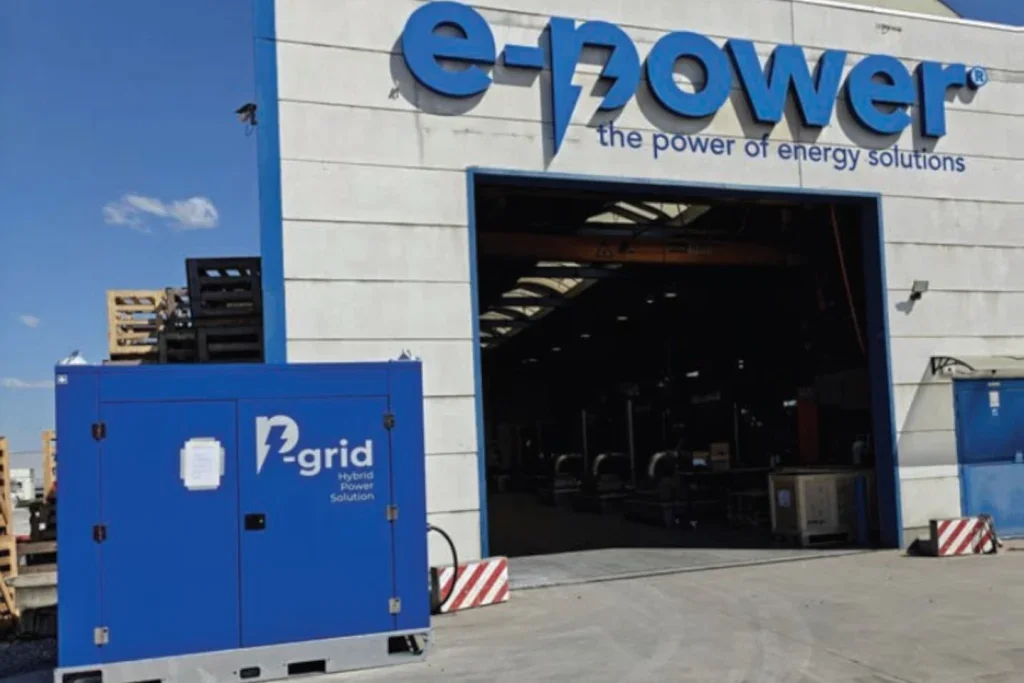
The Zenobë business model is an interesting one. “Basically we take on all the risk of transitioning from diesel to electric,” Long outlines. “We have done that for bus companies; now we are doing it for construction companies too. We don’t sell batteries; we sell the guaranteed ability to power your site. We look after the details. You don’t need to know how to look after your batteries, you don’t have to worry about a battery failing or about setting up the batteries on your site or optimising them for the particular cranes that are there and the energy requirements for that particular job. All you do is use the power that we guarantee will be on your site. Any problems that occur will be for us, not you, to sort out.”
The company has another ace up its sleeve: the batteries it uses are recycled ones. “We began by helping bus depots to transition from diesel to electric. We currently power 200 bus depots. But buses and cranes have different needs from their batteries.” And there is a beautiful synergy here which he describes…
“A bus has to cover 150km a day on a single charge of its battery; and when the battery is getting old, after about seven years, it loses the ability to hold so much charge; so it becomes useless for the bus company.
“But a crane battery does not need to run all day on a single charge. It can be trickle-charged at intervals, or all through the day. And unlike for a bus it does not have to deliver power all the time: just peak power in short bursts. So the battery that is now useless for buses does have a residual value: is still ideal for powering cranes. And being re-purposed it saves carbon twice over: by replacing diesel on the site, and by not needing all the energy-emissions that go into making a new battery. So on carbon savings you are getting two bites of the cherry.”
You are getting two economies as well: “If a client wants a firstuse newly-built battery we can, of course, supply one; but with a repurposed one they are getting a substantial saving on cost of the battery, as well as on all the diesel fuel that they no longer use.
“Transitioning from diesel is not simple. There are up-front costs – not only the cost of the battery itself but the cost of the technology of charging it.”
That means there is risk involved: a construction company investing in the new tech does not want to find itself with a battery that it has paid for but which does not work as planned. Hence the Zenobë business model and the new division it has started specifically for the construction industry. “We are calling it ‘Portable Power’ which describes exactly what we are offering.”
It is ‘whole-site’ power as well; you do not have to use the power only for your cranes. “You can charge up excavators or diggers overnight when the crane is not working; or you can charge electric cars and trucks. We call it an ‘electric Swiss Army knife’ – there are so many things that it can do.
And there is yet a third bite at the money-saving cherry: “Since it stores energy, you can buy your electrical energy from the grid provider at low-tariff times, at night or at weekends; and you can sell any surplus you may have back to the grid, but at peak times when they will pay you more for it. And we sort out the paperwork and technics and logistics of all that, so you do not have to.”
FUTURE FORECAST
As we have said, this is a new sector and a fast-moving one. Are we still in a transition stage for the technology or are there new developments likely to arrive soon?
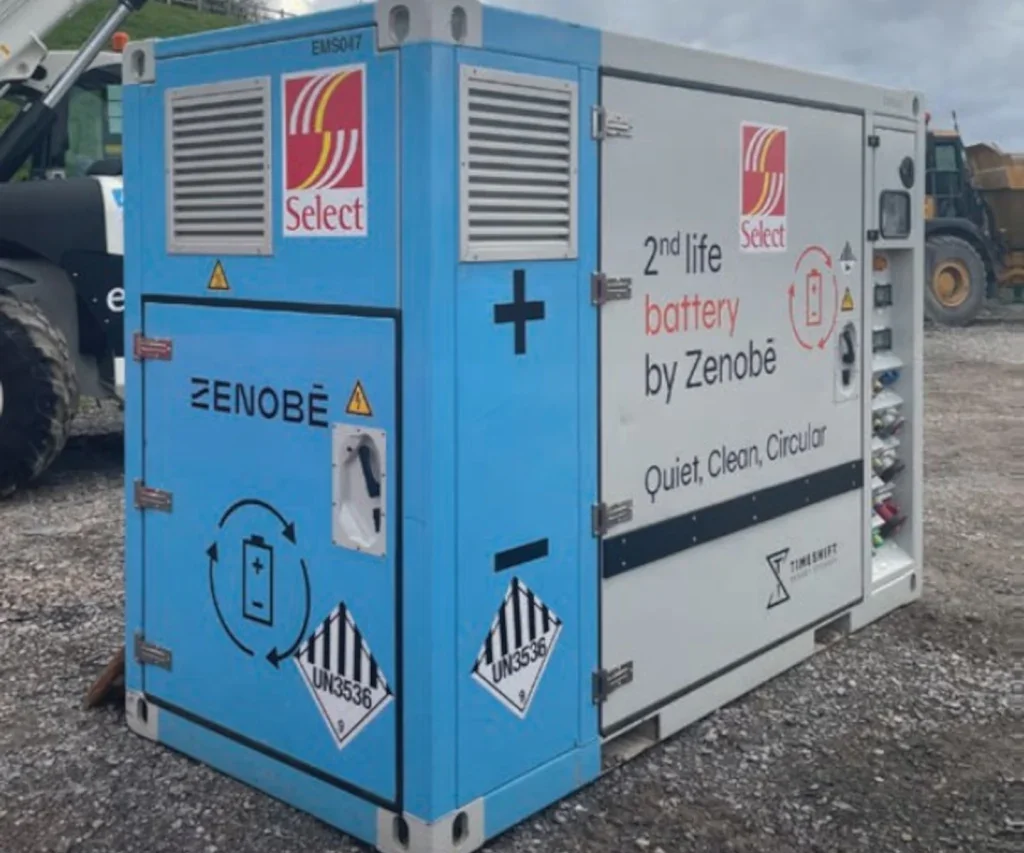
“I think lithium ion will be the technology for the near future,” says Long. “That is because what we’re doing is effectively piggybacking off the EV industry. So much technical investment in R&D has gone into lithium batteries for road vehicles, and that means that you can get competitively priced high-performing technology for these kinds of applications.
“There is always talk about solid-state batteries and sodium ion batteries with various benefits and downfalls compared to lithium ion, and I think these will be ones to keep an eye on, but for the near future lithium ion batteries will be the dominant technology in this in this space.”
And very soon, he thinks, every crane company will be in that space. “I expect that within three years every tower crane company will be using batteries. If there is a grid supply available that will always be the first choice, but what we’re finding is that because you can save so much diesel, a battery is already commercially more attractive than solely using a generator.
“It is not just a greenwashing way of saving carbon. You are making financial savings by swapping from a large generator to a battery to power a crane. That is the case already, and has been for a couple of years. We are saving customers more than a thousand pounds a week in some scenarios on fuel costs, and that is just on a single crane.”
It is clear from the above examples, battery technology is no longer a distant promise – it’s present day reality, transforming crane operations around the world. The shift from diesel to electric is being driven not just by environmental mandates but by clear operational advantages.
Crucially, this isn’t a one-sizefits- all revolution. Hybrid systems, flywheel technology, repurposed EV batteries all point to a future where electrification is not only possible but increasingly practical and profitable.
With both technological and commercial momentum behind it, battery power is no longer a niche innovation in lifting – it’s rapidly becoming the norm.
DELIVERING ON-DEMAND POWER WITH LIEBHERR’S LIDURO POWER PORT
Manufacturer Liebherr has been promoting its new Liduro Power Port, a mobile energy storage system developed within the group. It uses lithium-ion batteries to store energy and deliver it on-demand to various electrical consumers. The batteries are mounted on a wheeled chassis fitted with a drawbar, so it can easily be transported to the job site; the range consists of five models with power ratings ranging from 39 to 156 kWh.

CJ Bois, a French company specialising in the manufacture and assembly of timber frames and frameworks, used a Liduro LPO 100 for the construction of a public access building in the Auvergne- Rhône-Alpes region of France. The Liduro was recharged on-site using a 220 V single-phase socket (16 A / 2 kW), which could then be used to power a type 65 K.1 bottom-slewing crane on demand. It was also possible to connect a range of electro-portable tools directly to Liduro, such as frame screwdrivers, which require lots of power.
The energy could be delivered on-demand to meet power requirements of up to 20 kW (63 A) on the site, where timber elements weighing between 800 and 1,200kg were lifted.
“On the job site the Liduro was able instantly to deliver our peak power demands,” comments Christophe Chiampo, site manager at CJ Bois.


